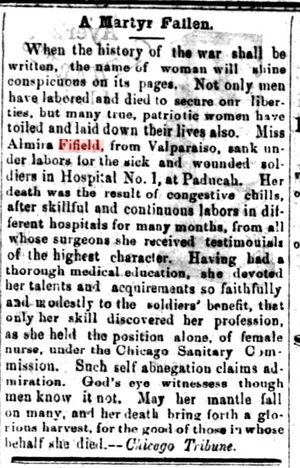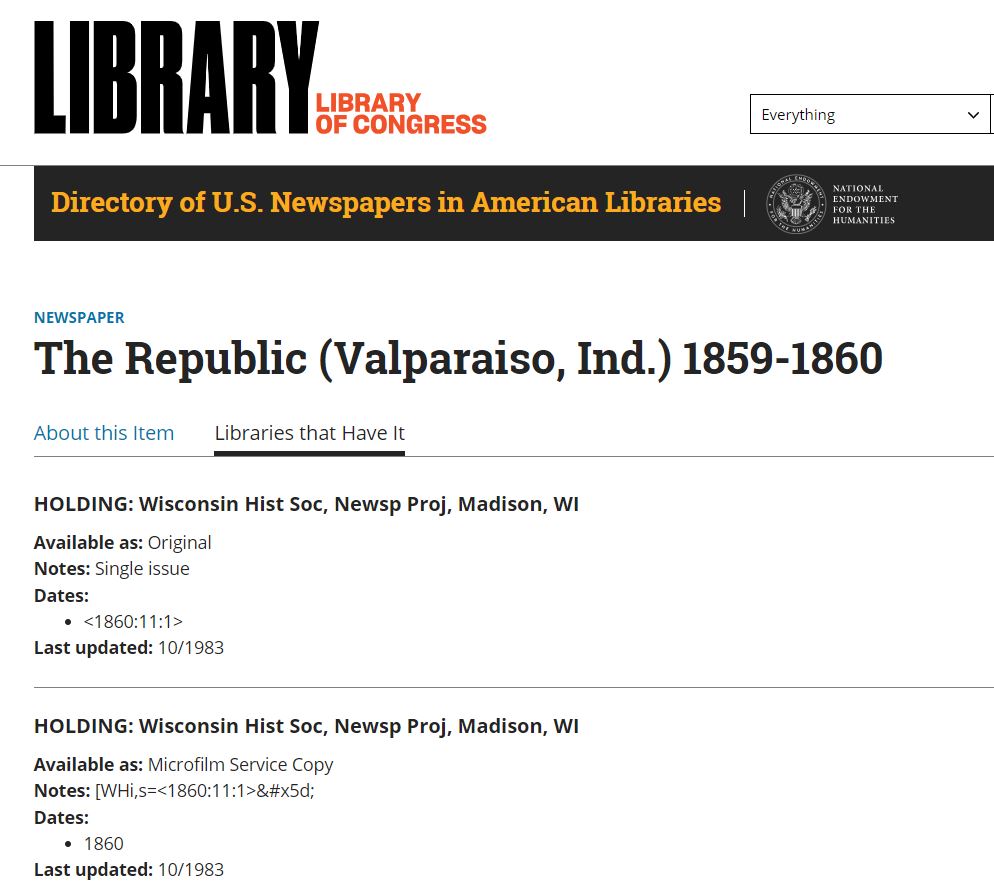In August of 2024, a concerned researcher from North Carolina contacted me about a missing person’s case, a lost story. Dr. Almira Fifield lost her life in 1863 while treating Union Soldiers in Paducah, Kentucky. (The patron’s middle name was also Fifield, a clue about her motivations.) This case was personal–but it was also important to the bulwark of women’s history. The patron was reviving the memory of a physician who was both a pioneer for women and a saint to soldiers suffering far from home.

Women were rarely mentioned by Victorian journalists, but the patron told me that Almira’s name had appeared briefly in two ads in the Valparaiso Republic newspaper in Porter County, Indiana. Unfortunately, Civil War-era issues of this title were so rare that not even the Indiana State Library held them. Fifield’s ads were, to coin a phrase, lost to history.
Looking in our microfilm database, I did not find 1858-1860 issues of the Valparaiso Republic. I tried our subscription databases and finally went to the Library of Congress newspaper section, the Chronicling America site, which informed me that this run of the Republic wasn’t available anywhere. After messaging the sad news to the patron, I decided to make one more attempt.

On rare occasions, our master reel vault has a run of films represent selections that are missing in the patron cabinets. Such mistakes were the result of a quick ingest of multiple master boxes from the Indiana Archives many years ago. Boxes arrived by the cartload when the two master collections were combined, and duplicate reels were sometimes overlooked. Incredibly, I located the lost Valparaiso Republic masters in the masters database and went to the vault to verify my findings. I struck gold. The master reels ran from 1857 to 1868 on assorted acetate, the yellow film boxes scribbled-on with blue ink. I ran the reels through a microfilm reader—best not to get the patron’s hopes up until I knew the films were viewable. The images on the screen were created very early in the filming era. Although they were fuzzy and shaded, they were mostly legible. I quickly emailed the patron again:
“I hope you get this message! I located your paper in our master reels vault: Valparaiso Republic, 1857-1865. (It isn’t in our finding system, but it was under the radar in the vault). Being a master, we have to use the positive/negative switch on the microfilm machine. It is poorly made, from the earliest days of filming, so the text is fuzzy and (in some places) nearly impossible to read. They also filmed it so that every other page is upside down, but the machine will flip the image for you.”
The patron told me that she had tears in her eyes while reading the message, adding that Fifield had been buried in an unmarked grave. The patron had only just secured a historical marker for Fifield, to be placed in Valparaiso. She arrived in the library within a week, and she found her ads.
But the joy of helping the patron was not the only immediate benefit to locating these lost issues. My newspaper information source is the Indiana Newspaper Bibliography, by John Miller. In the pages covering Porter County newspapers, I discovered another woman whose story deserved to be told.
The Republic’s owner, Dr. D. A. Cameron, enlisted in the Union Army and sold the paper to an entrepreneur who promptly abandoned it. The Republic was then secured again by Cameron’s wife Jane! Next, according to Miller, “The new arrangement failed, and the REPUBLIC suspended publication in December, 1863” (p 365). The implication was that Jane, in her womanly womanness, was unable to edit or conduct business. In fact, he wrote, the paper wasn’t revived until the man of the house returned from war in 1866.
Upon writing the book, Miller did not have the benefit of having the Valparaiso Republic films that I now had in front of me. Want to guess how Jane REALLY did with the publication? The issues continued in regular succession during Miller’s alleged down period, and therefore Jane Cameron deserves credit for maintaining an important Valparaiso title during the war—when the men in Porter County could not. And this, my friends, is how a humble newspaper run, once lost, can shine a light on forgotten heroes who—for the silliest of reasons– could not get a byline, let alone a headline.
The library will soon be ingesting another large quantity of master reels from the Indiana Archives, enough to require the transfer of the expanded collection into a different vault. The benefit will be having one collection manager (the ISL Newspaper Librarian) to monitor all state film management projects and requests from a single space and taxonomy. The expanded master reel collection will require database integration in Access. More importantly, master reels will be checked for duplicate counterparts, to uphold standards of patron use and preservation. Almira’s story will inspire my efforts! Does your repository have an “Almira story?”
